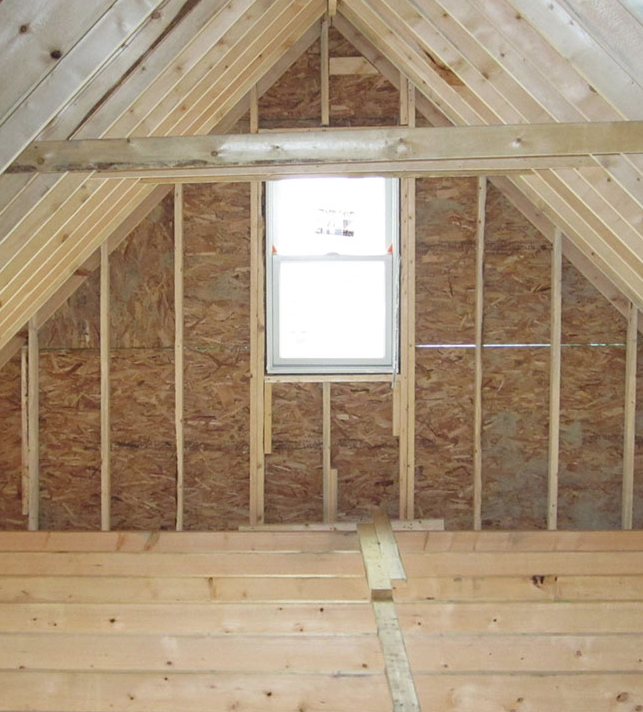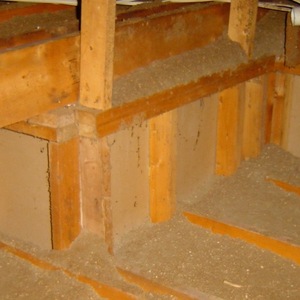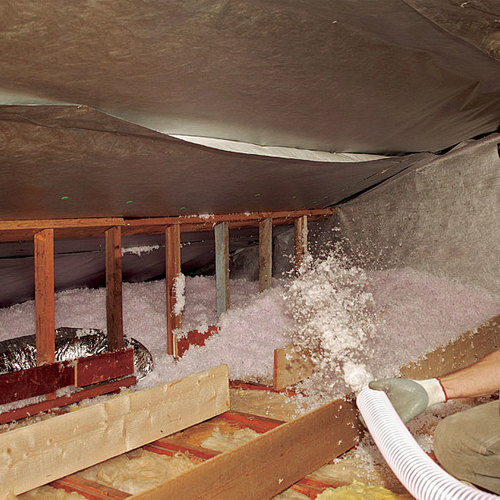
Image Credit: Image #1: Buildipedia
Maybe you are building a new home with an unconditioned vented attic. The house is framed, sheathed, and roofed. The drywall contractors have finished their work, so now you’re ready to insulate the attic floor.
If you are an owner-builder, this may be the first time you’ve done this. So what do you need to know?
Air sealing comes first
Although it’s common to talk about installing insulation on “the attic floor,” most attics don’t really have a floor. They have floor joists (or the bottom chords of roof trusses) with drywall below. When you are in the attic, you’re usually stepping carefully on top of the floor joists, looking down at the back side of the drywall ceiling.
You’ll be installing insulation on top of this drywall ceiling. (In some high-performance homes, builders install OSB rather than drywall in this location, and then install a service chase below the OSB. If you’re insulating the attic, however, it doesn’t matter very much whether there is a drywall ceiling below or an OSB ceiling below.)
If you care about energy performance, now is probably a good time for a blower-door test. You certainly can’t insulate your attic until you’ve finished your air sealing work — once the insulation is installed, tracking down air leaks is a real pain.
In most cases, air-sealing workers enter the attic after the drywall is installed, and seal the obvious leaks. The blower-door test occurs after this work is done. On the day of the blower-door test, it’s a good idea to have a few people on site, equipped with caulk, tape, and canned spray foam, so that any unexpected leaks discovered during the blower-door test can be quickly corrected.
Inspect the attic
So you are…
Weekly Newsletter
Get building science and energy efficiency advice, plus special offers, in your inbox.

This article is only available to GBA Prime Members
Sign up for a free trial and get instant access to this article as well as GBA’s complete library of premium articles and construction details.
Start Free TrialAlready a member? Log in















15 Comments
Gabled Luxury
How we long for something other than 4:1 hip roofs. Certainly not any in NE WI where almost every house built in the 60s was a bird cut rafter-ed hip roof. I'm dreaming of someday seeing something like those photos you like to use for this Web Site. Need another Peshtigo fire to clear the ruins.
When is R-38 the same as R-49?
Answer: in Zones 4 through 8, if you have full-height insulation over 100% of the ceiling including the top plates (as shown in your excellent guide here), the IECC allows R-38 rather than the R-49 that is required if you can't achieve full depth insulation over 100% of the attic floor.
It's an interesting exception...
See section 402.2.1: http://codes.iccsafe.org/app/book/content/2015-I-Codes/2015%20IECC%20HTML/Chapter%204%20%5BRE%5D.html
This 2015 language is updated a bit from the 2012 version, but both are supposed to say the same thing: if you have full depth insulation everywhere, you don't need as much.
Response to Douglas Horgan
Douglas,
Of course, as I'm sure you know, R-38 is not the same as R-49.
The intent of the code is to encourage builders to extend the insulation out so that it covers the top plates of the exterior walls -- an excellent goal. It's unfortunate, however, that the code writers decided to encourage what should be a standard practice by allowing builders to skimp on insulation depth.
Here is the language of the code exception:
"R402.2.1 Ceilings with attic spaces.
Where Section R402.1.2 would require R-38 insulation in the ceiling, installing R-30 over 100 percent of the ceiling area requiring insulation shall be deemed to satisfy the requirement for R-38 wherever the full height of uncompressed R-30 insulation extends over the wall top plate at the eaves. Similarly, where Section R402.1.2 would require R-49 insulation in the ceiling, installing R-38 over 100 percent of the ceiling area requiring insulation shall be deemed to satisfy the requirement for R-49 insulation wherever the full height of uncompressed R-38 insulation extends over the wall top plate at the eaves. This reduction shall not apply to the U-factor alternative approach in Section R402.1.4 and the total UA alternative in Section R402.1.5."
Wind Washing Dams
Greetings- Martin.
I understand the reason for installing the wind washing dams to protect the insulation below the insulation baffles. The part I am missing is the requirement for these baffles to be caulked and airtight around the perimeter. If the junction of the wall OSB and the top plate is sealed like in the picture, then what value is the caulking around dams?
Response to Jim Elliott
Jim,
Of course, many builders don't bother to seal the perimeter of their wind-washing dams. However, if wind is allowed to enter through these unsealed cracks, the performance of your fluffy insulation will be degraded at this crucial location. (When cold winter wind blows through fluffy insulation, it reduces the insulation's performance, just as a cold wind blowing through a wool sweater will make you feel cold during the winter. If you put a windbreaker over the sweater, you'll feel much warmer.)
If you live in a region with winter snowfall, the performance of the insulation at the perimeter of your attic is very important. Heat loss near the eaves leads to ice dams.
Bad link
For info, the link " Borrowing a Cellulose Blower From a Big Box Store" goes to the wrong subject.
Response to Bruce Lepper
Bruce,
Thanks very much for pointing out our error. I have fixed the broken link.
When work needs to be done in the attic after the insulation has buried the rafters, how do you know where to walk?
Thomas,
I'm guessing that you aren't really talking about rafters -- you are actually talking about joists.
If you need regular access to your attic, it makes sense to build a catwalk before you insulate the floor of your attic. To build a catwalk, you would usually elevate a section of the framing -- perhaps with 2x6s installed at 90 degrees to the joists -- and you would install OSB or plywood on top of the elevated framing. The idea is to provide enough vertical space between the OSB catwalk and the drywall ceiling below for all of your attic insulation -- and, of course, to provide a safe way to walk.
If you don't need regular access to your attic, but you need to perform a repair, you need to use common sense. Joists are usually either 16 inches or 24 inches on center. Once you have found one joist, you should have a pretty good idea of where the next joist can be found. You can feel around for the top of a joist with your foot -- or, alternatively, you can bring a bunch of OSB scraps or plywood scraps (perhaps 3 ft. by 3 ft., or 4 ft. by 4 ft.), and you can place these scraps above the joists to help you get around.
I have an old timber frame house with no soffit vents but it does have a ridge vent and two gable vents. There are no signs of condensation though the house is over 170 years old. The gable vents are large. Additionally, the eaves are framed with heavy timber and it would be very hard to install soffit vents.
Would you install wind-washing rigid foam in the eaves before adding fluffy insulation? I'm tempted to simply seal the wood itself with Great Stuff. The top plate is very heavy, as you might expect, and there is less than 12" around the eaves in which to stuff insulation.
The partitions are going to be very difficult to seal. 1 1/4" live edge chestnut boards are nailed vertically to the ceiling joists to create the partitions. I'm assuming I will have to fill in between these before I hang the sheetrock on them?
MKCF,
The purpose of wind-washing dams is to protect fluffy insulation from heat-robbing air flows. If you don't have any soffit vents, there won't be much air flow, so there really isn't any need for wind-washing dams.
That said, it's wise to leave an air space between the top of the insulation and your sheathing boards. Packing insulation tight to the bottom of the sheathing boards increases the risk of moisture accumulation in the boards (especially in very cold climates). A little air circulation allows the sheathing to stay dry.
Either fluffy insulation or spray foam insulation can be used in this area; needless to say, spray foam insulation has a higher R-value per inch.
I'm not sure why your attic has partitions. Is part of your attic finished (for example, as a bedroom)? If your attic is divided between finished (conditioned) space and unconditioned space, you clearly need partitions that are airtight and well-insulated. That should be fairly easy to accomplish with 2x4 or 2x6 studs, filled with insulation and faced with OSB, drywall, or rigid foam, as needed.
Sorry I was unclear about the partitions. I'm talking about second-story partitions nailed to ceiling joists (or attic floor-joists if you prefer). There is no top-plate, instead, the tops of the "studs" are nailed flat to the ceiling joists. In other words, the upstairs partitions are only 1 1/4" thick before you add drywall (originally it was plaster).
About the eaves... the top plate of the walls is 8x8 chestnut, and the soffits are attached to this, somehow. There are pegs. I'm sure air can enter along the eaves as there is daylight in a few places, I guess this to be where the roof deck meets the molding on the exterior. The soffit is made of heavy timber with pegs driven vertically, not sure exactly how this works but I'm sure it's simple yet effective, structurally speaking.
MKCF,
My answer is unchanged -- both for the eaves and the partitions.
Just because you have existing 1.25-inch-thick partitions at the present time doesn't mean you can't add studs, insulation, and one or more air barriers. Alternatively (assuming you don't need any wiring in the partitions) you could add one or more layers of rigid foam to the existing partitions, followed by drywall.
Thanks! I feel much better about proceeding to insulate the eaves. Sadly spray foam isn't in the budget, so I will have some heat loss in the eave area, but at least I can install my fluffy insulation with confidence. It will still be waaaayy better than it was. I'm trying to hit R-60 in the rest of the attic.
I came upon this site explaining what the options are for a walk-up attic. Basically, they recommend either foaming the rafters or sealing off the stairway with a tight-fitting attic hatch. What do you think of using the attic hatch? I thought maybe I could put in the hatch, build up my attic floor with cross-joists or mini-walls and then put cellulose in to a pretty good depth. Then, I can put down some OSB to walk on and to store a few things.
I could just foam the rafters and be done, that would be easier, but it would mean I have to heat the attic then. I don't care about the attic except to store a few things, so it seems to make sense to do the hatch instead?
https://www.halcoenergy.com/insulation/photo-gallery/24349-album-treating-a-walk-up-attic-in-rochester-ny.html
Log in or become a member to post a comment.
Sign up Log in